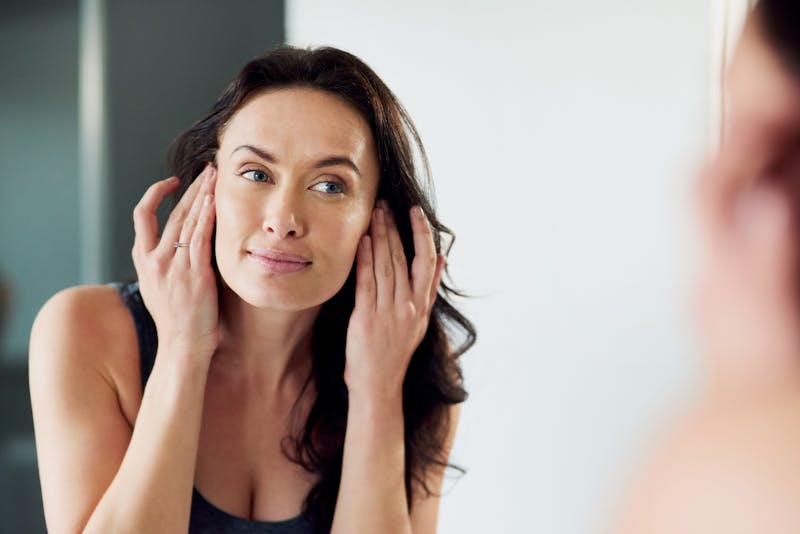
Have you noticed that right after waxing, threading, and other hair removal treatments, your upper lip still appears dark? Well, it might not be just hair. It could be a condition known as melasma mustache. Surprisingly, almost half of all women will experience melasma at some point in their lives, with the most common occurrence being on their face. Despite its prevalence, melasma is something we don't talk about. Let's get the conversation started!
What is Melasma?
Melasma, also known as hyperpigmentation, pigmentation, skin discoloration, or dark spots, refers to any condition that causes darker patches of skin on the face or body. The color of the patches can vary depending on your skin tone. They can appear as light brown, dark brown, or even blue-grey.
Melasma is a skin condition caused by an excessive production of melanin, which gives color to your hair, eyes, and skin. When your body produces more melanin than necessary, it can result in the formation of dark spots, ranging from small freckles to blotchy patches. On the upper lip, melasma usually appears as a cluster of tiny spots that would be difficult to spot individually but create the appearance of upper lip hair due to their close proximity.
What Are The Top Causes of Melasma?
Hyperpigmentation can appear out of nowhere. Knowing what its cause is empowers you to take a proactive and reactive approach.
Hormonal Changes
Over 90% of those diagnosed with melasma are women, and it’s something 50% of women are affected by. Fluctuating estrogen levels can cause an increase in melanin production, resulting in skin discoloration. Women may experience this discoloration for the first time when they start taking birth control, become pregnant, or as their hormones change during perimenopause. During pregnancy, this condition is commonly known as the "mask of pregnancy" or chloasma.
UV and Sun Exposure
It’s important to apply broad-spectrum UV protection every day, even during winter, for many reasons. One of them is to reduce the risk of melasma mustache or pigmentation on areas of your skin that are regularly exposed. Sun and UV exposure, including blue light from electronic devices and fluorescent lighting, can accelerate the production of melanin, which can cause sunspots, liver spots, and brown spots. Sun spots are so common, that adults over the age of 50 have at least one.
Acne and Scarring
It's almost impossible to avoid post-inflammatory hyperpigmentation. When acne or any kind of injury like a cut, scrape, or burn occurs, your skin is likely to scar. Your body has a natural healing process and during this process, your skin creates more melanin at the site of the injury. This type of melasma can fade away without any targeted treatment, but it can fade faster with targeted aesthetic treatments.
Is Melasma Painful?
Melasma is 100% pain-free. That is unless your skin is still healing from recent acne or a skin injury. You should seek immediate medical attention if you have an itchy, red, or irritated mole or dark spot.
Although painless, having pigmented skin can cause self-consciousness, particularly when it appears on your face, neck, or other exposed areas.
Why Is Melasma More Common On The Face?
You’re more likely to have uneven skin tone in areas that are regularly exposed to direct sunlight. Your face, neck, hands, and arms are likely to be exposed daily, which is why you’re most likely to see dark spots in these areas.
Will My Melasma Mustache Fade On Its Own?
If the dark spot is due to acne or a skin injury, it's likely to fade away on its own over time. If it developed during pregnancy, there's a chance it might fade away on its own. However, if it's caused by sun exposure or perimenopause, it might not fade away without proper care and treatment using the tips mentioned below.
Does Melasma Get Darker?
UV and hormonal melasma may darken and enlarge over time, unlike standard scarring which typically doesn't darken.
How Long Does it Take For Hyperpigmentation to Fade?
If addressed early while discoloration is mild, you may see results for hormonal and UV melasma in a few months. Depending on the treatment, you may see improvement in 3 to 6 treatments. Without targeted treatment, it may take years, or your melasma may darken without treatment.
How is Melasma Mustache Treated?
Let's explore the treatment options for a melasma mustache, including what to do and what to avoid, and how to take a proactive and reactive approach.
#1 Never, Ever Bleach Your Skin!
If you're feeling self-conscious due to skin discoloration on your upper lip, face, or body, you might be searching for a quick fix. There are many skin-bleaching and skin-lightening products available online that claim to provide rapid results. However, most of these products are highly toxic, containing harmful substances like mercury, hydroquinone, and other toxins. These substances are banned for skincare and can cause skin irritation and damage.
The team at Valley Medical Weight Loss and Med Spa understands that you want to look your best, but there's no need to risk your health!
#2 Conceal With Makeup
Switching your foundation to a color-correcting cream (CC cream) is the fastest and easiest way to mask melasma and even out your skin tone. CC creams are specifically formulated for this purpose. If you prefer lighter coverage, you can opt for a foundation or powder that contains light-reflecting particles. These products are often referred to as "photo-ready" and their light shimmer helps minimize discoloration on your skin.
#3 Explore Safe Dark Spot Treatments
There are several skincare products available over the counter that can help reduce dark spots. These products are generally labeled as "skin brightening" or "dark spot correctors" and can be online or in beauty departments. The best part is, they do not contain harsh or toxic chemicals that can harm your skin. Most of these formulas contain niacinamide or Vitamin C, or sometimes ingredients combined.
- Niacinamide: Also known as vitamin B3, niacinamide has been proven to fade dark spots when applied topically twice daily for 2 months. However, it's worth noting that results don't improve beyond the 2-month point—but you can keep using it as a proactive product. The good news is that topical niacinamide is safe for sensitive skin and provides various skincare benefits, such as shrinking your pores.
- Vitamin C: Vitamin C is a highly beneficial antioxidant that should be incorporated into every anti-aging skincare routine. It's particularly useful in treating melasma mustache as it contains an enzyme that helps to fade scars and prevent the overproduction of melanin. However, if you have sensitive skin, it's important to ensure that the vitamin C product you use has a maximum of 10% concentration. Products with 15% or 20% concentration may cause skin irritation.
- Retinol: Retinol helps to reduce the appearance of dark spots and hyperpigmentation by promoting cell turnover and exfoliation. Over-the-counter products may not be strong enough, so you may need to seek a prescription product. Retinol can irritate sensitive skin and you must use sunscreen daily as retinol can increase skin sensitivity to the sun.
#4 Apply Broad-Spectrum UV Protection Daily
As mentioned earlier, exposure to UV rays can speed up melanin production, which can increase the likelihood of developing melasma. To prevent this, apply a broad-spectrum sunscreen with a minimum protection of 50 year-round. Broad-spectrum sunscreen provides protection against all potentially harmful rays, including those emitted by electronic devices and fluorescent light bulbs. This type of sunscreen is different from SPF protection, which only shields against the sun’s rays, not against all UV rays. UV protection is also proactive.
Reapply every 2 hours when outside, and every 4 hours when indoors. If you'll be swimming or sweating, use a waterproof formula.
#5 Genetics
Facial pigmentation can be genetic. If hyperpigmentation runs in your family, you may want to take a proactive approach. Daily UV projection is at the top of the list, but Valley Medical can provide proactive tips to personalize your whole-body skincare.
#6 Reach Out to Valley Medical!
Treating hyperpigmentation of any kind is one of the many aesthetic options we provide. The cause, severity, location of discoloration, and how long it’s been present will influence your options. We’ll also take your skin tone and skin type into consideration. From minimally invasive treatments to 100% pain-free treatments.
Ready to Erase Your Melasma Mustache?
If your melasma leaves you feeling less than your best, reach out to discuss your treatment options.
Valley Medical Weight Loss and Med Spa has 3 locations in Phoenix, Glendale, and Tempe. Let’s get started!

